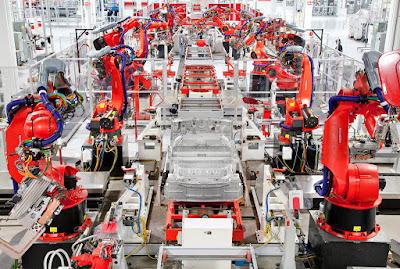Week 3: Robotics and Art
Art and robotics are often seen as
separate, but some of the most amazing pieces of functional art incorporate
robotics in its construction. However, before delving deeper into the links
between robotics and art, it is prudent to talk about how the industrial
revolution led on to the development of robotics. The assembly line emerged from
the industrial revolution to increase production of products. Originally people
were employed but today they are often robots. This is most apparent in
automobile assembly lines. Despite robots replacing humans, some aspects will always
require a human’s hand.
 |
| Tesla car assembly line |
Car designers exist today to design
the bodywork of a car and their artworks are created by robots. These designers
are often considered artists as Dr. Hufnagl, former director of the International
Design Museum Munich, says “the automobile is not simply regarded as a
functional high-tech construction built by engineers…it is indeed viewed first
and foremost as an object of art experienced with the senses, through the
designer's rendering of form, materials and colour”. In this way, the bodywork
of a mass-produced car is, in a way, a piece of art. However, not everyone
shares this point of view. Walter Benjamin argues that art is distinguished by the
“ritual” in which it was produced and because of its “ritual” is different from
copies. This argument I find difficult to accept as in the case of the car
designer, his art is only expressed in the assembly line where hundreds of
pieces are made, yet the “ritual” is the same for all of them. Each of the cars
on the assembly line can be regarded as an “original” through the common “ritual”
of being produced by robotics.
 |
| Poster for the movie 2001: A Space Odyssey |
Additionally, western society is
wary of close connections between man and machine. Whether it was fear of
becoming a cog in the assembly line during the industrial revolution, or
artificial intelligence controlling humans as seen in movies like 2001: A Space Odyssey, these fears led
people to distance themselves from machines. Thus, some may not consider
artworks produced by robots, as in the case of car designers, to be art as they
delineate a clear divide between humans and machines. I believe that one should
not exclude works made by machines just because a human did not have a hand in
the entirety of an artwork’s production. Sometimes art can only be expressed through
robotics and mass production.
References
Bangle,
C. (2002). Great Cars are Great Art. TedTalk.
Benjamin,
W. (1936). The Work of Art in the Age of Mechanical Reproduction.
Davis, D.
(1995). The Work of Art in the Age of Digital Reproduction (An Evolving Thesis:
1991-1995). Leonardo, 28(5), 381. http://dx.doi.org/10.2307/1576221
DeMorro,
C. (2014). Belgian Factory Workers Beg For Tesla Takeover | Gas 2. Gas 2.
Retrieved 23 April 2018, from
https://gas2.org/2014/12/26/belgium-factory-workers-beg-tesla-takeover/
Glamour
Space Odyssey Poster And Amazing Ideas Of 2001 A Space Odyssey Poster Posters
19 - Best Posters. (2018). Togomeetings.com. Retrieved 23 April 2018, from
http://www.togomeetings.com/100669/space-odyssey-poster.html/glamour-space-odyssey-poster-and-amazing-ideas-of-2001-a-space-odyssey-poster-posters-19
Knuth, D.
(1974). Computer Programming as an Art. Communications Of The ACM, 17(12),
667-673.
Red Dot
Design Award: The art of car design. (2004). Red Dot. Retrieved 23 April 2018,
from https://en.red-dot.org/408.html
Verborgh,
R. (2013). Programming is an Art. Ruben Verborgh. Retrieved from
https://ruben.verborgh.org/blog/2013/02/21/programming-is-an-art/


Hi, I enjoyed reading your take on the design/production of cars to be representative of both robotics and art. I understand why you might have a hard time accepting Benjamin's argument about the problem with mechanical reproduction of artwork. Although his argument might not be as applicable in regards to the production of supercars where craftsmanship can be unarguable, I believe that there is some validity to his argument when discussing more affordable cars. Because of mass production of affordable cars, these cars are often bought for their functionality and reasonable price tags rather than for their artistic values. In this case, Benjamin shows that with mass reproduction, the artistic value of a product (such as a car) is depreciated.
ReplyDelete